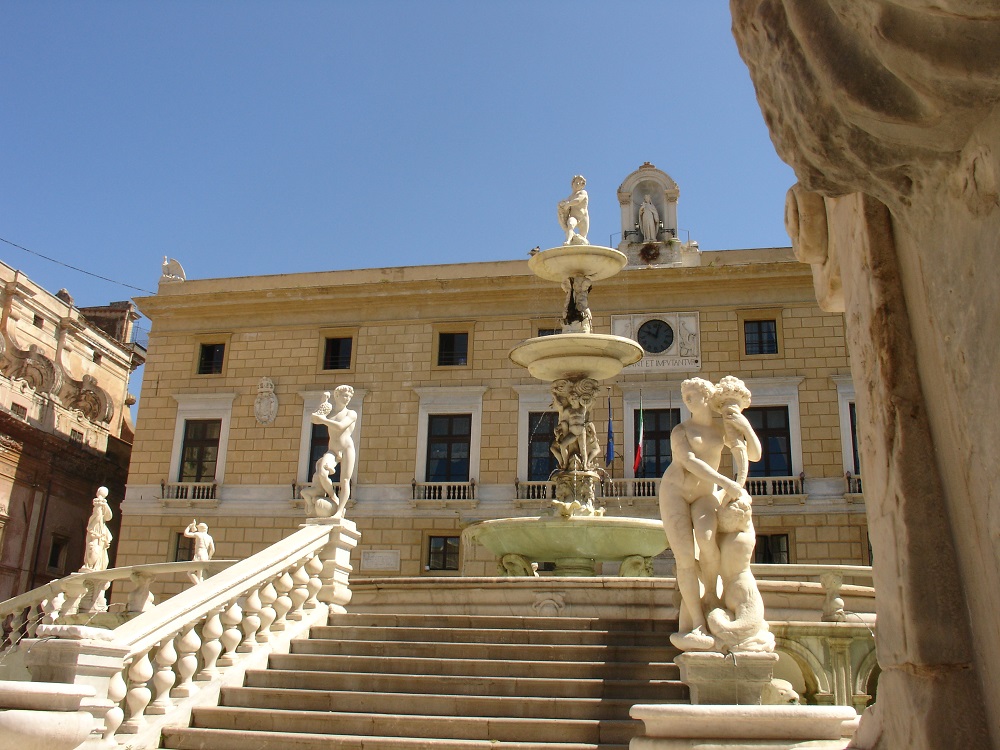
Read English version
Il Palazzo Pretorio, fatto edificare dal pretore Pietro Speciale, si affaccia sulla piazza e sulla fontana omonime. I lavori sotto la guida di Giacomo Benfante durarono dal 1463 al 1478. Il progetto originario era a pianta quadrangolare e ogni facciata aveva il suo ingresso; quello principale era di fronte alla chiesa di S. Cataldo. Il palazzo subì diverse trasformazioni nei secoli XVI e XVII in seguito ai grandi eventi urbanistici che mutarono il volto di questa parte della città. Intorno al 1553 il Palazzo fu ampliato e la facciata su piazza Pretoria divenne quella principale.
Foto di Salvatore Torcivia
Venne nuovamente sistemato nel 1615-17 da Mariano Smiriglio e definitivamente ristrutturato nel 1873-75. La facciata principale, coperta da intonaco a stucco, presenta tre ordini di otto finestre con nel piano nobile una sola fila di nove balconi ; questi hanno balaustre di marmo, decorate con colonnine e piccole teste di leone scolpite sotto le mensole. Sotto il balcone centrale è scolpita in altorilievo una grande aquila marmorea, opera di Salvatore Valenti. Sopra cornicione della facciata principale sono la statua di S. Rosalia e gli scudi con le insegne della città e del viceré di Castro, opera di Carlo d’Aprile (1661); sotto questa è un orologio da torre fatto giungere da Parigi nel 1864, racchiuso dal Damiani dentro una cornice di pietra di forma rettangolare. In cima all’edificio, ai quattro angoli, sono quattro aquile in cemento stuccate ad imitazione del marmo da Domenico Costantino. Attraverso un portale di fine XVII secolo, la cui parte interna presenta una ricca decorazione barocca con colonne tortili, si accede ad un imponente scalone di fine ‘500 che conduce al piano nobile. E’ giusto sul lato sinistro della scalone che si trova uno dei più famosi busti del Genio di Palermo, il protettore laico della città.
Le ricche sale del Palazzo custodiscono pregiate opere darte.Tra le sale visitabili si segnalano: la Sala delle Lapidi, ora sala consiliare, con le pareti ricoperte appunto di iscrizioni su lastre di marmo e con al centro un bel lampadario ligneo secentesco ricavato da un unico pezzo e la Sala Garibaldi dal cui balcone l’eroe si affacciò per parlare alla folla nel 1860. In una bacheca sulla destra sono conservate le armi con intarsi e fodero in oro e madreperla appartenute a Napoleone.

ENGLISH
It was re-arranged in 1615-17 by Mariano Smiriglio and finally renovated in 1873-75. The main façade, covered with stucco plaster, presents three orders of eight windows with a single row of nine balconies in the main floor. These balconies have marble balustrades, decorated with small columns and small lion heads carved under the shelves. Under the central balcony there is a large marble eagle carved in high relief by Salvatore Valenti. Above the cornice of the main facade there are the statue of S. Rosalia and the shields with the insignia of the city and of the Viceroy of Castro, by Carlo dAprile (1661); below there is a tower clock brought from Paris in 1864, and then it was enclosed inside a rectangular stone frame by Damiani. At the top of the building, at the four corners, there are four cement eagles stuccoed in imitation of marble by Domenico Costantino. Through a portal of the late seventeenth century, whose internal part presents a rich Baroque decoration with twisted columns, there is the access to an imposing staircase from the end of the 16th century leading to the main floor. On the left side of the staircase there is one of the most famous busts of the Genius of Palermo, the secular protector of the city.
The rich halls of the Palace house some valuable works of art. Among the halls, two of them can be visited: la sala delle Lapidi (the Hall of the Tombstones), now a council hall, with walls covered with inscriptions on marble slabs and with a beautiful seventeenth-century wooden chandelier carved from a single piece and the Garibaldi Hall from whose balcony the hero appeared to talk to the crowd in 1860. In a showcase on the right there are preserved weapons with inlays and scabbard in gold and mother-of-pearl belonged to Napoleon.
Address: Piazza Pretoria tel 091 740 11 11- web site: click here
Visit / timetable: Monday to Saturday 08.30 / 08.00pm. Sunday 08.30 am /1.00 pm. Except for institutional commitments
Ticket: free – Please Note: for the period of covid emercency the building will not be open to visitors
